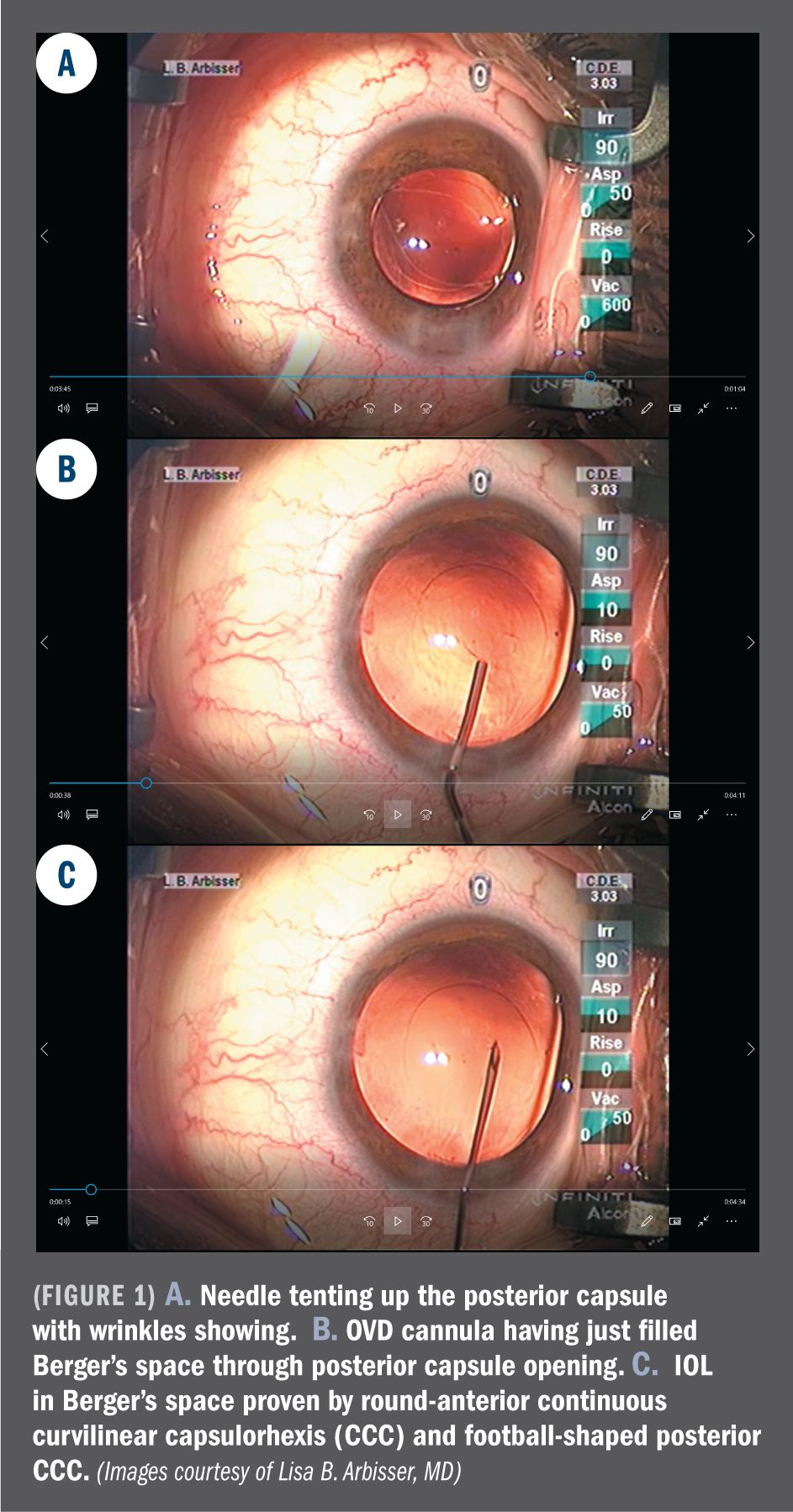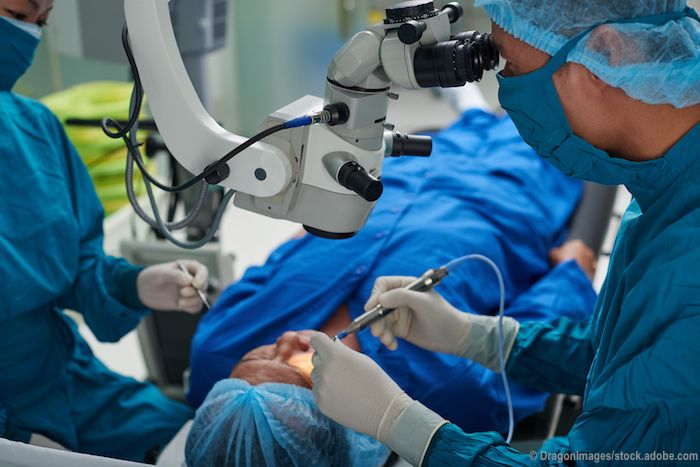News
Article
Primary posterior optic capture offers many advantages in cataract surgery
Author(s):
Approach enables patients to maintain best possible vision with one-time only procedure


Lisa B. Arbisser, MD, explains why primary posterior optic capture should be routine in cataract surgery and describes her technique.
Reviewed by Lisa B. Arbisser, MD
Hyaloid-Sparing primary posterior optic capture should one day be routine in cataract surgery because it enables patients to maintain the best possible vision with a one-time only procedure, according to Lisa B. Arbisser, MD.
“Posterior optic capture with IOL haptics in the bag and the optic prolapsed through a posterior capsulotomy into Berger’s space allows a clear visual axis for life even when done in the pediatric age group without anterior vitrectomy and in all adults, truly turning cataract surgery into a premium procedure,” said Dr. Arbisser, adjunct professor, Moran Eye Center, University of Utah, Salt Lake City.
This technique reduces retinal straylight produced by the “clear” posterior capsule, resulting in better initial vision, she added. The technique “eliminates risk of secondary visual degradation from posterior capsule opacification (PCO) and therefore the need for planned anterior vitrectomy in children and hyaloid busting Nd:YAG laser posterior capsulotomy in adults,” Dr. Arbisser said.
“It obviates the need for a square-edged optic because the square edge is only necessary to retard PCO when the IOL is in the bag,” she added. In addition, it can also eliminate the dysphotopsia that is related to the square-edge design. As another benefit, it brings predictability to the effective lens position by reducing or eliminating lens epithelial cell fibrosis and contraction and eliminates the risk of postoperative rotation when using a toric lens, Dr. Arbisser noted.
Reasonable learning curve
Performing posterior optic capture involves some extra time and skill, but the added time is minimal, just about 1 to 2 minutes, and the learning curve is not too challenging, Dr. Arbisser noted. Surgeons should expect to perform about 150 cases to reach the expert-level, she added.
“Transitioning from extracapsular cataract extraction to phacoemulsification was a gigantic learning curve, but learning to do a posterior continuous curvilinear capsulorhexis for posterior capsule optic capture involves a minor addition to skills already mastered for anterior capsulorhexis,” she explained.
“The main hurdle may be more of a mental block, as we were always taught not to break the posterior capsule at all costs,” she added. The best cases to offer posterior optic capture initially are for patients who cannot sit for a Nd:YAG laser capsulotomy and require general anesthesia for cataract surgery, Dr. Arbisser said.
“This is the cohort that benefits the most from one surgical procedure providing permanent clarity of vision for life,” she said.
Surgical steps
Describing her technique-taught to her by Rupert Menapace MD, Vienna, Austria-Dr. Arbisser said that after cataract removal and placing an ophthalmic viscosurgical device (OVD) in the sulcus, she uses a 30-gauge needle positioned bevel up to lift the 5-μm thick posterior capsule from the anterior hyaloid and create a posterior capsule flap initiating the rhexis.
Then, a cohesive OVD is injected through the posterior capsule opening to push the hyaloid posteriorly and make Berger’s space real.
“The OVD remains in Berger’s space, which is the space between the posterior capsule and the anterior hyaloid, and in the sulcus, creating a planar area to work in with the anterior and posterior capsules ‘pancaked’ together,” Dr. Arbisser said. Performing the posterior capsulotomy is not difficult, but compared with doing an anterior capsulorhexis, it requires that surgeons use higher magnification, a little more centripetal force, and more frequent regrasping because of the elasticity of the posterior capsule.
“There is no tendency for the tear to run out, because there is no convexity to the posterior capsule, the tear obeys the vector force applied to it,” Dr. Arbisser said. The anterior capsulorhexis is used as a guide to make a 4- to 5-mm round opening.
The anterior capsulorhexis should always be confirmed as capturable before attempting the posterior rhexis as it is the “safety-net rescue” and can be used for anterior capture from the sulcus or reverse optic capture from the bag in the event of an unsuccessful posterior continuous curvilinear capsulorhexis (PCCC) or tear during posterior capture, Dr. Arbisser said.
Once the continuous posterior capsulotomy is completed, the capsular bag is inflated by placing OVD into the bag fornix. Though a single-piece lens is used by some surgeons-and in the United States, it is sometimes needed because the case involves a multifocal or toric IOL-Dr. Arbisser prefers a three-piece implant because the risk of late vitreous prolapse could be greater with the single-piece lens.
“The IOL should ideally have a sharp optichaptic junction that will help assure the capture and minimize IOL-lens epithelial cell interaction,” she added.
Rather than pushing on the optic 90° away from the optic-haptic junction to “pop” the optic into position, Dr. Arbisser said it may be necessary to “walk” the instrument along the optic slightly toward the optic-haptic junction on either side of 90° to ensure a good capture from junction to junction and the ideal football appearance of the captured PCCC edge for the thinner posterior capsulorhexis.
Documented safety
The posterior optic capture technique was first described by Howard Gimbel, MD, in 1990. Nearly 30 years later, there is ample evidence in the literature that supports its safety.
“Opening the posterior capsule does not compromise the integrity of the barrier between the front and the back of the eye because the two compartments are really separated by the anterior hyaloid, and there is ample proof the two chambered eye remains intact,” Dr. Arbisser said.
“There are more than 60 peer-reviewed papers about posterior optic capture by multiple authors,” she said. “Per data from fellow eye prospective controlled trials and experience in more than 5,000 routine patients, it does not increase the incidence of postoperative cell and flare, cystoid macular edema, retinal detachment, or IOP increase, either early or late.”
Long-term studies should logically show decreases in these and other pathologies as the hyaloid is stabilized for life and need never be disrupted by Nd: YAG laser posterior capsulotomy.
Dr. Arbisser is also studying a new idea of her own called hyaloid-sparing double capture (HSDC) wherein the IOL haptics are placed in the sulcus and the optic captured through both anterior and posterior capsulotomies into Berger’s space with undisturbed hyaloid.
“HSDC may address the incidence of late bag-lens-subluxation in addition to eliminating PCO, both of which are unfortunate sequelae of today’s standard cataract surgery,” she concluded.
Disclosures:
Lisa B. Arbisser, MD
E: drlisa@arbisser.com
This article was adapted from Dr. Arbisser’s presentation at the 2018 meeting of the American Academy of Ophthalmology. Dr. Arbisser is a consultant for Mynosys and is a minor stockholder in the company.
Newsletter
Don’t miss out—get Ophthalmology Times updates on the latest clinical advancements and expert interviews, straight to your inbox.





